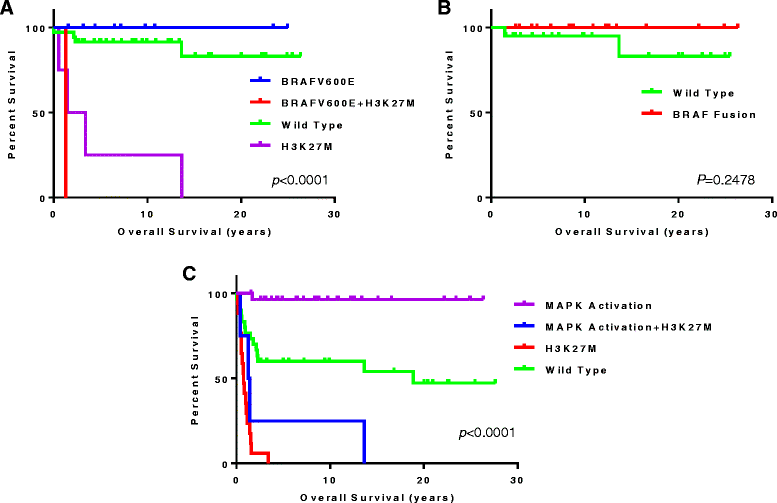Targeted detection of genetic alterations reveal the prognostic impact of H3K27M and MAPK pathway aberrations in paediatric thalamic glioma
- PMID: 27577993
- PMCID: PMC5006436
- DOI: 10.1186/s40478-016-0353-0
Targeted detection of genetic alterations reveal the prognostic impact of H3K27M and MAPK pathway aberrations in paediatric thalamic glioma
Abstract
Paediatric brain tumours arising in the thalamus present significant diagnostic and therapeutic challenges to physicians due to their sensitive midline location. As such, genetic analysis for biomarkers to aid in the diagnosis, prognosis and treatment of these tumours is needed. Here, we identified 64 thalamic gliomas with clinical follow-up and characterized targeted genomic alterations using newly optimized droplet digital and NanoString-based assays. The median age at diagnosis was 9.25 years (range, 0.63-17.55) and median survival was 6.43 (range, 0.01-27.63) years. Our cohort contained 42 and 22 tumours reviewed as low and high grade gliomas, respectively. Five (12 %) low grade and 11 (50 %) high grade gliomas were positive for the H3F3A/HIST1H3B K27M (H3K27M) mutation. Kaplan-Meier survival analysis revealed significantly worse overall survival for patients harbouring the H3K27M mutation versus H3F3A/HIST1H3B wild type (H3WT) samples (log-rank p < 0.0001) with a median survival of 1.02 vs. 9.12 years. Mitogen-activated protein kinase (MAPK) pathway activation via BRAF or FGFR1 hotspot mutations or fusion events were detected in 44 % of patients, and was associated with long-term survival in the absence of H3K27M (log-rank p < 0.0001). Multivariate analysis demonstrated H3K27M status and high grade histology to be the most significant independent predictors of poor overall survival with hazard ratios of 6.945 and 7.721 (p < 0.0001), respectively. In contrast, MAPK pathway activation is a predictor of favourable patient outcome, although not independent of other clinical factors. Importantly, we show that low grade malignancies may harbour H3K27M mutations and that these tumours show a dismal survival compared to low grade H3WT cases. Our data strongly supports the inclusion of targeted genetic testing in childhood thalamic tumours to most accurately stratify patients into appropriate risk groups.
Keywords: BRAF; H3K27M; MAPK; Pediatric; Prognostic; Thalamic glioma.
Figures



Similar articles
-
Significance of H3K27M Mutation in "Nonmidline" High-Grade Gliomas of Cerebral Hemispheres.World Neurosurg. 2019 Nov;131:174-176. doi: 10.1016/j.wneu.2019.08.024. Epub 2019 Aug 12. World Neurosurg. 2019. PMID: 31415896
-
Significance of H3K27M mutation with specific histomorphological features and associated molecular alterations in pediatric high-grade glial tumors.Childs Nerv Syst. 2018 Jan;34(1):107-116. doi: 10.1007/s00381-017-3633-5. Epub 2017 Oct 24. Childs Nerv Syst. 2018. PMID: 29063957
-
H3F3A K27M mutations in thalamic gliomas from young adult patients.Neuro Oncol. 2014 Jan;16(1):140-6. doi: 10.1093/neuonc/not144. Epub 2013 Nov 26. Neuro Oncol. 2014. PMID: 24285547 Free PMC article.
-
The prognostic significance of HIST1H3B/C and H3F3A K27M mutations in diffuse midline gliomas is influenced by patient age.J Neurooncol. 2022 Jul;158(3):405-412. doi: 10.1007/s11060-022-04027-2. Epub 2022 May 23. J Neurooncol. 2022. PMID: 35606633 Review.
-
The clinicopathological and prognostic significance of TP53 alteration in K27M mutated gliomas: an individual-participant data meta-analysis.Neurol Sci. 2018 Jul;39(7):1191-1201. doi: 10.1007/s10072-018-3407-1. Epub 2018 Apr 12. Neurol Sci. 2018. PMID: 29651718 Review.
Cited by
-
Are Thalamic Intrinsic Lesions Operable? No-Man's Land Revisited by the Analysis of a Large Retrospective, Mono-Institutional, Cohort.Cancers (Basel). 2023 Jan 5;15(2):361. doi: 10.3390/cancers15020361. Cancers (Basel). 2023. PMID: 36672311 Free PMC article.
-
Updates in prognostic markers for gliomas.Neuro Oncol. 2018 Nov 9;20(suppl_7):vii17-vii26. doi: 10.1093/neuonc/noy158. Neuro Oncol. 2018. PMID: 30412261 Free PMC article.
-
Histone H3K27M Mutation Overrides Histological Grading in Pediatric Gliomas.Sci Rep. 2020 May 20;10(1):8368. doi: 10.1038/s41598-020-65272-x. Sci Rep. 2020. PMID: 32433577 Free PMC article.
-
Molecular-targeted therapy for childhood low-grade glial and glioneuronal tumors.Childs Nerv Syst. 2024 Oct;40(10):3251-3262. doi: 10.1007/s00381-024-06486-6. Epub 2024 Jun 15. Childs Nerv Syst. 2024. PMID: 38877124 Review.
-
Infiltrative gliomas of the thalamus in children: the role of surgery in the era of H3 K27M mutant midline gliomas.Acta Neurochir (Wien). 2021 Jul;163(7):2025-2035. doi: 10.1007/s00701-020-04589-y. Epub 2020 Oct 22. Acta Neurochir (Wien). 2021. PMID: 33090244 Free PMC article.
References
-
- Becker AP, Scapulatempo-Neto C, Carloni AC, Paulino A, Sheren J, Aisner DL, Musselwhite E, Clara C, Machado HR, Oliveira RS, Neder L, Varella-Garcia N, Reis RM. KIAA1549:BRAF gene fusion and FGFR1 hotspot mutations are prognostic factors in pilocytic astrocytomas. J Neuropathol Exp Neurol. 2015;74:743–754. doi: 10.1097/NEN.0000000000000213. - DOI - PMC - PubMed
Publication types
MeSH terms
Substances
Grants and funding
LinkOut - more resources
Full Text Sources
Other Literature Sources
Medical
Research Materials
Miscellaneous

